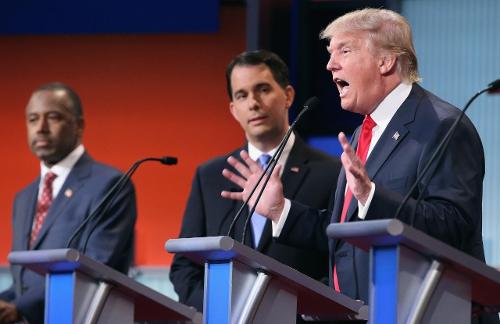
Donald Trump participates in the first primetime presidential debate hosted by Fox News and Facebook at the Quicken Loans Arena in Cleveland. (Photo: Chip Somodevilla/Getty Images)
Like a lot of you — OK, like four of you, anyway — I made time to tune into the warmup Republican debate yesterday afternoon, the one for the seven candidates who barely registered in the polls. And the more I heard from them, the more I thought: You know what? These Republican voters might just know what they’re doing.
When Carly Fiorina’s such a standout that Rick Perry offers to make her secretary of state, you know you’re not dealing with the A-team.
Then I watched the main event a few hours later. What I saw there were several serious and talented politicians who might well have the skills needed to get themselves elected and actually govern — all of whom punted on a clear opportunity to demonstrate it.
You see, the primetime debate brought into sharp relief the actual schism that divides the Republican candidates heading into the fall. It isn’t conservative versus moderate. It isn’t simply insiders versus outsiders, or the party establishment versus the Tea Party types.
It’s about governing Republicans versus ideological provocateurs. It’s politicians who believe in wielding and reforming government as a vehicle for change on one hand, and those who see a career in public service as a mark of ineptitude, if not an outright vice, on the other.

The 10 leading candidates to this point break down roughly into equal groups, although a few of them (namely Scott Walker and Rand Paul) are hard to categorize. On the governing side you have Jeb Bush, Marco Rubio, John Kasich and Chris Christie.
The provocateurs include Mike Huckabee, Ben Carson and Ted Cruz, but the loudest, crassest voice in the pack clearly belongs to Donald Trump.
It took only a few minutes for Trump to start denigrating everybody who chooses to serve in government rather than do something truly ennobling, like build casinos and high-rises for millionaires.
“Our leaders are stupid,” Trump said in regard to immigration, after refusing to rule out an independent run and laughing off his record of misogyny. “Our politicians are stupid.” (Mexico’s leaders, he added, are considerably smarter and “more cunning.”)
Which more or less elicited this response from the governing Republicans on stage: Oh. OK, then.
I mean, not entirely. Bush talked about the power of education reform, and Kasich had a nice riff about lifting up the poor through more efficient programs, and Christie pushed his plan to modernize Social Security. Each of them sounded downright Clintonian at times — as in Bill, not Hillary.
But where Clinton coupled his calls for policy reform with a spirited defense of government generally, the best potential nominees in the Republican Party just stood there while Trump dismissed everyone who serves in government as a moron.
When Kasich, who served with distinction for 18 years in Congress before winning two terms as governor of Ohio, was asked to respond specifically to Trump’s “idiot” comment, he responded with compliments.
“I was just saying to Chris Christie, they say we’re outspoken?” Kasich said. “We really need to take lessons from Donald Trump!” And then this: “People who want to just tune him out, they’re making a mistake.” And then: “We all have solutions.”
I get it. None of the party’s serious thinkers wants to give Trump yet more oxygen by getting drawn into a brawl. They probably figure he’ll flame out at some point, and when he does, where’s the upside in having alienated his disaffected supporters?
But let me break it to you, guys: You’re not getting Trump’s supporters. They don’t like what you stand for. They don’t like government, period.
And so there was an obvious moment Thursday night when somebody on that stage could have stepped up and played the part of Joseph Welch to Trump’s Joe McCarthy. (“Have you no sense of decency, sir?”) There was a chance for Christie to flash some of that famous indignation (he managed to summon it easily enough for Paul), or for Bush to show some of the sure-footedness and fire that a lot of Republicans are waiting for.
You’d think at least one governing Republican would have the courage to jump in and say: You know what, Trump? Governing matters. Politics matters. It helps to know something about policymaking before you go running down everyone who devotes years of their lives to it.
It’s true that most people who get themselves elected to something or who lead government agencies will never own a tower with their names on it. But that doesn’t make them stupid; it makes them committed.
And, just by the way, while you were pretending to fire people on TV, a bunch of us were agonizing over hard decisions that affected millions of families devastated by a real recession. We may be stupid, but we’re not callous, and we’re not amateurs.
Seems to me a moment like that might have done a lot to lift one of these guys out of the middling pack. It might have resonated with all those other conservative voters — the ones who nominated George W. Bush and John McCain and Mitt Romney, because in the end they aspired to something more than a doomed revolt.
What voters want, too, is a nominee who won’t let himself get pushed around when his closely held values are under attack. On that score, you can give this round to the bully.







